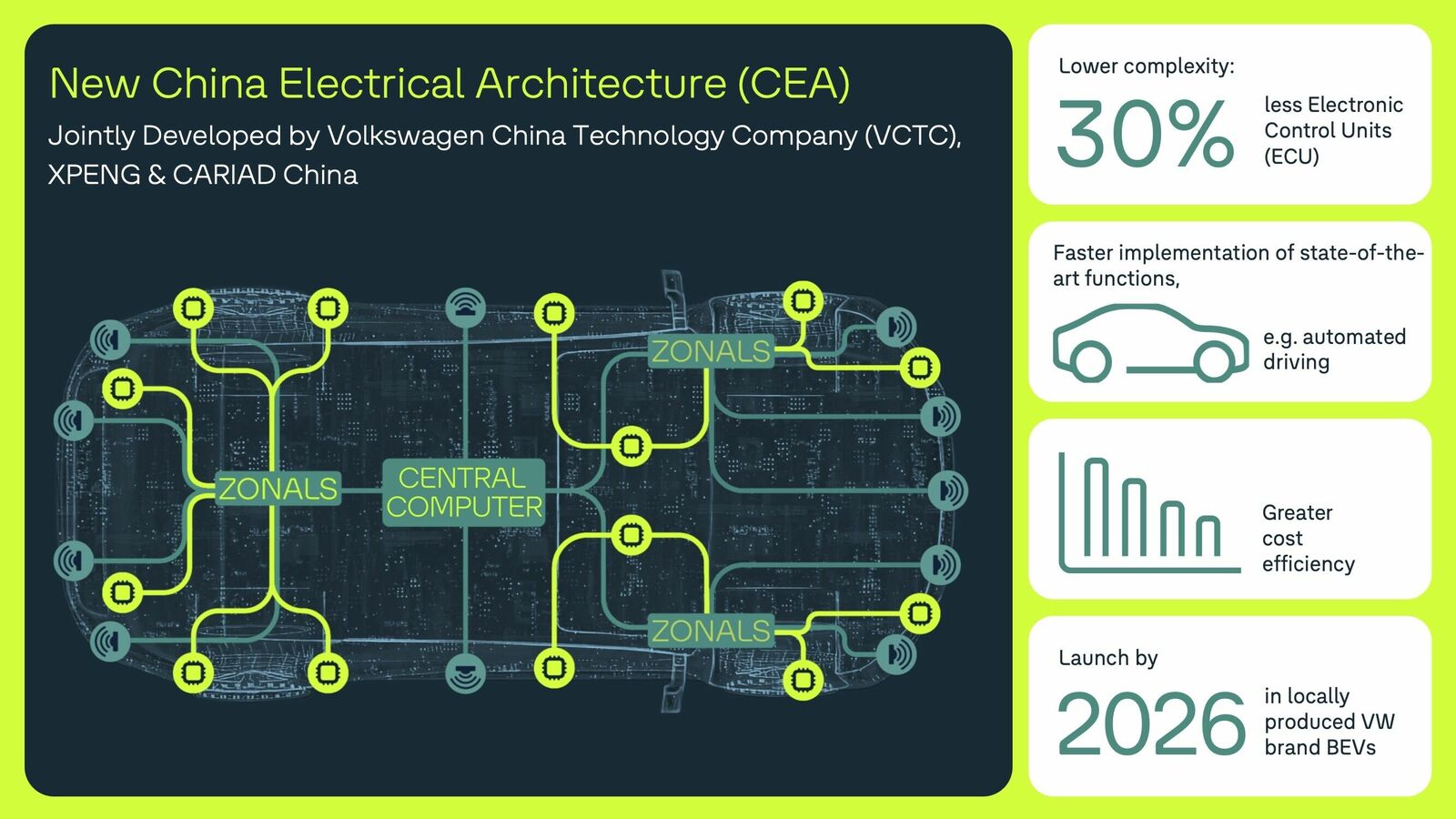By implementing the new CEA the Volkswagen brand is further standardising the digital architecture of its locally produced model portfolio. Initially, the focus is on vehicles on the locally developed platforms. This includes four VW brand models in the entry-level of the compact class segment on the China Main Platform (CMP) which is being developed by Volkswagen China Technology Company (VCTC) together with the Joint Ventures SAIC Volkswagen and FAWVolkswagen. By reducing complexity and the number of control units, the CEA is making a significant contribution to achieving the 40% cost reduction target for the China platform compared to MEB. The cars on CMP will hit the market as of 2026 and comprehensively expand the portfolio of the Joint Ventures.
The CEA will also strengthen the digital offering in the two VW brand vehicles developed jointly with XPENG for the mid-range segment. Launched in 2026 - starting with a SUV.
Ralf Brandstätter, Member of the Board of Management of Volkswagen AG for China, said: “With our 'In China, for China' strategy, we are strengthening the innovative power of the Volkswagen Group in China. By expanding our partnership with XPENG and consistently integrating with China's industrial ecosystem, we will align our products even faster to the needs of Chinese customers. Both partners bring their strengths to the table. This increases efficiency, optimises cost structures and accelerates the speed of development. High cost-effectiveness and a fast pace of development are crucial for our competitiveness in China's dynamic market environment. Through such efforts, we are taking on a leading role in the age of intelligent connected vehicles.”
Xiaopeng He, Chairman and CEO of XPENG, said: “Our shared passion for technology brought XPENG and Volkswagen together. Both parties will continue to contribute each other’s best to our strategic partnership. The technical collaboration on E/E architecture takes our partnership to the next level and on a much larger scale. The collaboration will allow our Smart EV products to be both technologically competitive and cost competitive.”
VCTC and CARIAD China to ensure rapid integration of new digital technologies into VW models
The CEA will jointly be developed by a team of experts from XPENG, VCTC and CARIAD China, who together will strengthen the software-oriented approach and foster the development of state-ofthe- art features, i.e. automated driving and next-generation connectivity functionalities. The partnership ensures the construction of a comprehensive zonal E/E architecture including the zone controllers, central computers, cloud and backend connectivity, and fast and cost-efficient integration into Volkswagen brand vehicles. VCTC, a development, innovation, and procurement center, is the core of the Hefei innovation hub. VCTC bundles all of Volkswagen’s development units and decision-making processes for vehicles destined for the Chinese market. By the end of this year, more than 3,000 development and procurement experts will be working on the development of new ICVs. CARIAD China, with more than 1,000 experts, is Volkswagen Group China’s software unit. Their target is to significantly shorten development times by up to 30 per cent in order to bring innovative offerings to customers faster.
Volkswagen Group strengthens its local development expertise through strong ‘in China, for China’ approach
The expanded co-operation with the smart vehicle company XPENG ties in with the Group’s ‘In China, for China’ strategy, as it enables Volkswagen to address market-defining trends in China at an early stage and best leverage the market’s growth dynamics and innovative strength. Volkswagen is strengthening its local development capacities for e-mobility, digitalisation and autonomous driving and accelerating its decision making and development processes in the region. As a result, the Group is expanding its site in Hefei into a state-of-the-art production, development and innovation hub, while also focusing on partnerships with Chinese high-tech companies. A high level of technical localisation and consistent customer orientation are the key for Volkswagen Group China and its Joint Ventures SAIC Volkswagen, FAW-Volkswagen and Volkswagen Anhui to take over a leading role in the new ICV era.






